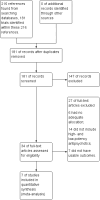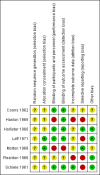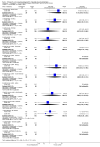Trifluoperazine versus low-potency first-generation antipsychotic drugs for schizophrenia
- PMID: 25003310
- PMCID: PMC11227318
- DOI: 10.1002/14651858.CD009396.pub2
Trifluoperazine versus low-potency first-generation antipsychotic drugs for schizophrenia
Abstract
Background: Antipsychotic drugs are the core treatment for schizophrenia. Treatment guidelines state that there is no difference in efficacy between any other antipsychotic compounds, however, low-potency antipsychotic drugs are often perceived as less efficacious than high-potency compounds by clinicians, and they also seem to differ in their side-effects.
Objectives: To review the effects in response to treatment of trifluoperazine and low-potency antipsychotics for people with schizophrenia.
Search methods: We searched the Cochrane Schizophrenia Group's Trials Register (November 2010).
Selection criteria: We included all randomised trials comparing trifluoperazine with first-generation low-potency antipsychotic drugs for people with schizophrenia or schizophrenia-like psychosis.
Data collection and analysis: We extracted data independently. For dichotomous data we calculated risk ratios (RR) and their 95% confidence intervals (CI) on an intention-to-treat basis based on a random-effects model.
Main results: The review currently includes seven randomised trials involving 422 participants that compared trifluoperazine with low-potency antipsychotic drugs. The size of the included studies was between 20 and 157 participants with a study length between four and 52 weeks. Overall, sequence generation, allocation procedures and blinding were poorly reported. Trifluoperazine was not significantly different from low-potency antipsychotic drugs in terms of response to treatment (trifluoperazine 26%, low-potency drug 27%, 3 RCTs, n = 120, RR 0.96 CI 0.59 to 1.56, moderate quality evidence). There was also no significant difference in acceptability of treatment with equivocal number of participants leaving the studies early due to any reason (trifluoperazine 20%, low-potency antipsychotics 16%, 3 RCTs, n = 239, RR 1.25, CI 0.72 to 2.17,low quality evidence). There was no significant difference in numbers with at least one adverse effect (trifluoperazine 60%, low-potency antipsychotics 38%, 1 RCT, n = 60, RR 1.60, CI 0.94 to 2.74, moderate quality evidence). However, at least one movement disorder was significantly more frequent in the trifluoperazine group (trifluoperazine 23%, low-potency antipsychotics 13%, 2 RCTs, n = 123, RR 2.08 CI 0.78 to 5.55, very low quality evidence) as well as incoordination (trifluoperazine 20%, low-potency antipsychotics 5%, 1 RCT, n = 60, RR 7.00, CI 1.60 to 30.66) and rigor (trifluoperazine 45%, low-potency antipsychotics 10%, 1 RCT, n = 60, RR 4.50, CI 1.58 to 12.84). No data were available for other outcomes of interest death, sedation and quality of life.
Authors' conclusions: The results did not show a difference in efficacy between trifluoperazine and low-potency antipsychotics. Trifluoperazine produced more movement disorders. The number of randomised studies as well as their quality is low, the quality of evidence for outcomes of interest ranged from moderate to very low quality, so more, newer studies would be needed for conclusions about the relative effects of trifluoperazine and low-potency antipsychotics.
Conflict of interest statement
Magdolna Tardy ‐ none to declare.
Markus Dold ‐ none to declare.
Rolf Engel ‐ none to declare.
Stefan Leucht ‐ has received honoraria for lectures from Abbvie, Astra Zeneca, BristolMyersSquibb, ICON, EliLilly, Janssen, Johnson & Johnson, Roche, SanofiAventis, Lundbeck and Pfizer; honoraria for consulting/advisory boards from Roche, EliLilly, Medavante, BristolMyersSquibb, Alkermes, Janssen, Johnson & Johnson and Lundbeck. EliLilly has provided medication for a study with SL as primary investigator.
Figures














Update of
- doi: 10.1002/14651858.CD009396
References
References to studies included in this review
Coons 1962 {published data only}
-
- Coons WH, Boyd BA, White JG. Chlorpromazine, trifluoperazine and placebo with long‐term mental hospital patients. Canadian Psychiatric Association Journal 1962;7(4):159‐63. - PubMed
Hanlon 1965 {published data only}
-
- Hanlon TE, Michaux MH, Ota KY, Shaffer JW, Kurland AA. The comparative effectiveness of eight phenthiazines. Psychopharmacologia 1965;7:89‐106. - PubMed
Hollister 1960 {published data only}
-
- Hollister LE, Erickson GV, Motzentecker FP. Trifluoperazine in chronic psychiatric patients. Journal of Clinical and Experimental Psychopathology 19610;21:15‐23. - PubMed
Leff 1971 {published data only}
Morton 1968 {published data only}
-
- Morton MR. A study of the withdrawal of chlorpromazine or trifluoperazine in chronic schizophrenia. American Journal of Psychiatry 1968;124(11):1585‐8. - PubMed
Reardon 1966 {published data only}
-
- Reardon JD, Abrams S. Acute paranoid schizophrenia (treatment with chlorpromazine, trifluoperazine and placebo). Diseases of the Nervous System 1966;27:265‐70. - PubMed
Schiele 1961 {published data only}
-
- Schiele BC, Vestre ND, Stein KE. A comparison of thioridazine, trifluoperazine, chlorpromazine, and placebo: a double‐blind controlled study on the treatment of chronic hospitalized, schizophrenic patients. Journal of Clinical and Experimental Psychopathology 1961;22:151‐62. - PubMed
References to studies excluded from this review
Barsa 1959 {published data only}
-
- Barsa JA, Saunders JC, Kline NS. Trifluoperazine in the treatment of chronic schizophrenics. American Journal of Psychiatry 1959;115(9):812. - PubMed
Casey 1961 {published data only}
-
- Casey JF, Hollister LE, Klett CJ, Lasky JJ, Caffey EM. Combined drug therapy of chronic schizophrenics. Controlled evaluation of placebo, dextro‐amphetamine, imipramine, isocarboxazid and trifluoperazine added to maintenance doses of chlorpromazine. American Journal of Psychiatry 1961;117:997‐1003. - PubMed
Childers 1964 {published data only}
-
- Childers RT, Therrien R. A comparison of the effectiveness of trifluoperazine and chlorpromazine in schizophrenia. American Journal of Psychiatry 1964;118:552‐4. - PubMed
Crane 1970 {published data only}
-
- Crane GE. High doses of trifluperazine and tardive dyskinesia. Archives of Neurology 1970;22(2):176‐80. - PubMed
de Jong 1965 {published data only}
-
- Jong J. Efficacy of phenothiazines without antiparkinson drugs. Diseases of the Nervous System 1965;26(11):702‐4. - PubMed
DeWolfe 1971 {published data only}
-
- DeWolfe AS, Barrell RP, London L, Spaner FE. Prolixin enanthate and thorazine‐stelazine regimens in the treatment of schizophrenic patients. An experimental evaluation. Psychosomatics 1971;12(3):186‐90. - PubMed
Eitan 1992 {published data only}
-
- Eitan N, Levin Y, Ben Artzi E, Levy A, Neumann M. Effects of antipsychotic drugs on memory functions of schizophrenic patients. Acta Psychiatrica Scandinavica 1992;85(1):74‐6. - PubMed
Freyhan 1959 {published data only}
-
- Freyhan FA. Therapeutic implications of differential effects of new phenothiazine compounds. American Journal of Psychiatry 1959;116:577‐85. - PubMed
Gardos 1970 {published data only}
-
- Gardos G, Finnerty RJ, Cole JO. Thiothixene and trifluoperazine in a step system. Psychosomatics 1970;11(1):36‐40. - PubMed
Gillis 1977 {published data only}
-
- Gillis JS. The effects of selected antipsychotic drugs of human judgment. Current Therapeutic Research, Clinical and Experimental 1977;21(2):224‐32. - PubMed
Hamilton 1963 {published data only}
-
- Hamilton M, Hordern A, Waldrop FN, Lofft J. A controlled trial on the value of prochlorperazine, trifluoperazine and intensive group treatment. British Journal of Psychiatry 1963;109:510‐22. - PubMed
Hershon 1972 {published data only}
-
- Hershon HI, Kennedy PF, McGuire RJ. Persistence of extra‐pyramidal disorders and psychiatric relapse after withdrawal of long‐term phenothiazine therapy. British Journal of Psychiatry 1972;120(554):41‐50. - PubMed
Jones 1971 {published data only}
-
- Jones IH, Pikler N. Effects of chlorpromazine and trifluoperazine on the activity of chronic schizophrenics. British Journal of Psychiatry 1971;119(552):545‐6. - PubMed
Marjerrison 1966 {published data only}
-
- Marjerrison G, Hrychuk W, Varsanyi EI. A comparison of two butyrophenones with trifluoperazine. Canadian Psychiatric Association Journal 1966;11(1):26‐30. - PubMed
Platz 1967 {published data only}
-
- Platz AR, Klett CJ, Caffey EM. Selective drug action related to chronic schizophrenic subtype (A comparative study of carphenazine, chlorpromazine, and trifluoperazine). Diseases of the Nervous System 1967;28(9):601‐5. - PubMed
Prien 1968 {published data only}
-
- Prien RF, Levine J, Cole JO. High dose therapy in chronic schizophrenia ‐ trifuoperazine. Proceedings of the 121st Annual Meeting of the American Psychiatric Association; 1968 May 13‐17; Boston, Massachusetts, USA. 1968.
Prien 1969 {published data only}
-
- Prien RF, Levine J, Cole JO. High dose trifluoperazine therapy in chronic schizophrenia. American Journal of Psychiatry 1969;126(3):305‐13. - PubMed
Rudy 1958 {published data only}
-
- Rudy L, Rinaldi E, Himwich H, Tuteur W, Glotzer J. Trifluoperazine in the treatment of psychotic patients. American Journal of Psychiatry 1958;115:364‐5. - PubMed
Smith 1958 {published data only}
-
- Smith JA, Christian D, Rutherford A, Mansfield E. A comparison of triflupromazine (vesprin), chlorpromazine and PLACEBO in 85 chronic patients. American Journal of Psychiatry 1958;115:253‐4. - PubMed
Spiegel 1967 {published data only}
-
- Spiegel DE, Keith‐Spiegel P. The effects of carphenazine, trifluoperazine and chlorpromazine on ward behavior, physiological functioning and psychological test scores in chronic schizophrenic patients. Journal of Nervous and Mental Diseases 1967;144(2):111‐6. - PubMed
Teja 1975 {published data only}
-
- Teja JS, Grey WH, Clum JM, Warren C. Tranquilizers or anti‐depressants for chronic schizophrenics: a long term study. Australian and New Zealand Journal of Psychiatry 1975;9(4):241‐7. - PubMed
Terminska 1989 {published data only}
-
- Terminska K, Mrowiec W. Comparison of influence of perazine, fluphenazine, trifluoroperazine, chloropromazine and haloperidol on primary and deficit schizophrenic symptoms in patients first hospitalized because of paranoid schizophrenia [Badanie porownawcze wplywu perazyny, flufenazyny, trifluoroperazyny, chloropromazny i haloperydolu na objawy pierwotne i deficytowe pierwszego zachorowania na schizofrenie paranoidalna]. Psychiatria Polska 1989;23(1):24‐30. - PubMed
Vestre 1970 {published data only}
-
- Vestre ND, Schiele BC. Differential drug effects of two phenothiazines (A controlled comparison of thioridazine and trifluoperazine in chronic schizophrenics). Diseases of the Nervous System 1970;31(12):821‐5. - PubMed
Vinar 1968 {published data only}
-
- Vinar O, Taussigova D. Clinical experience with trifluoperazine. Activitas Nervosa Superior 1968;8:447‐51.
Welbel 1980 {published data only}
-
- Welbel L. Differences in the clinical effect of various neuroleptics [Roznice w dziallaniu klinicznym niektorych neuroleptykow]. Psychiatria Polska 1980;14(2):113‐8. - PubMed
Weston 1961 {published data only}
-
- Weston FK, Loftus AP. A terminal double‐blind trial of tri‐fluoperazine ("stelazine") in chronic schizophrenia. Medical Journal of Australia 1961;48(1):776‐80. - PubMed
Wilson 1961 {published data only}
-
- Wilson IC, McKay J, Sandifer MG. A double‐blind trial to investigate the effects of thorazine (largactil, chlorpromazine), compazine (stemetil, prochlorperazine) and stelazine (trifluoperazine) in paranoid schizophrenia. Journal of Mental Science 1961;107:90‐9. - PubMed
Additional references
Altman 1996
Andreasen 2010
Berger 2003
-
- Berger M. Psychische Erkrankungen. Klinik und Therapie. 2nd Edition. München: Urban & Fischer, 2003.
Bland 1997
Boissel 1999
-
- Boissel JP, Cucherat M, Li W, Chatellier G, Gueyffier F, Buyse M, et al. The problem of therapeutic efficacy indices. 3. Comparison of the indices and their use. Therapie 1999;54(4):405‐11. - PubMed
Campbell 2000
-
- Campbell M, Grimshaw J, Steen N. Sample size calculations for cluster randomised trials. Changing Professional Practice in Europe Group (EU BIOMED II Concerted Action). Journal of Health Services Research and Policy 2000;5:12‐6. - PubMed
Carpenter 1994
-
- Carpenter WT, Buchanan RW. Schizophrenia. New England Journal of Medicine 1994;330:681‐90. - PubMed
Davis 1974
-
- Davis JM. Overview: maintenance therapy in psychiatry: I. Schizophrenia. American Journal of Psychiatry 1975;132(12):1237‐45. - PubMed
Davis 1989
-
- Davis JM, Barter JT, Kane JM. Antipsychotic drugs. Comprehensive Textbook of Psychiatry. Williams and Wilkins, 1989.
Deeks 2000
-
- Deeks J. Issues in the selection for meta‐analyses of binary data. Proceedings of the 8th International Cochrane Colloquium; 2000 Oct 25‐28th; Cape Town, South Africa. Cape Town, 2000.
Der‐Simonian 1986
-
- Der‐Simonian R, Laird N. Meta‐analysis in clinical trials. Controlled Clinical Trials 1986;7:177‐88. - PubMed
Divine 1992
-
- Divine GW, Brown JT, Frazer LM. The unit of analysis error in studies about physicians' patient care behavior. Journal of General Internal Medicine 1992;7:623‐9. - PubMed
Egger 1997
Elbourne 2002
-
- Elbourne DR, Altman DG, Higgins JP, Curtin F, Worthington HV, Vail A. Meta‐analyses involving cross‐over trials: methodological issues. International Journal of Epidemiology 2002;31:140‐9. - PubMed
Falkai 2005
-
- Falkai P, Wobrock T, Lieberman J. World Federation of Societies of Biological Psychiatry (WFSBP) ‐ Guidelines for biological treatment of schizophrenia, part 1: Acute treatment of schizophrenia. World Journal of Biololgical Psychiatry 2005;6:132‐91. - PubMed
Furukawa 2011
-
- Furukawa TA, Akechi T, Wagenpfeil S, Leucht S. Relative indices of treatment effect may be constant across different definitions of response in schizophrenia trials. Schizophrenia Research 2011;126:212‐9. - PubMed
Gaebel 2006
-
- Gaebel W, Falkai P, Weinmann S. Behandlungsleitlinie Schizophrenie. Darmstadt: Steinkopff, 2006.
Gulliford 1999
-
- Gulliford MC, Ukoumunne OC, Chinn S. Components of variance and intraclass correlations for the design of community‐based surveys and intervention studies: data from the Health Survey for England 1994. American Journal of Epidemiology 1999;149:876‐83. - PubMed
Haase 1983
-
- Haase HJ. Dosierung der Neuroleptika. Ein Leitfaden für Klinik und Praxis unter besonderer Berücksichtigung psychotisch Kranker. Erlangen: Perimed Fachbuch‐Verlagsgesellschaft, 1983.
Hathaway 1940
-
- Hathaway, SR, McKinley, JC. A multiphasic personality schedule (Minnesota). Journal of Psychology 1940;10:249‐54.
Higgins 2008
-
- Higgins JPT, Deeks JJ, Altman DG (editors). Chapter 16: Special topics in statistics. In: Higgins JPT, Green S editor(s). Cochrane Handbook for Systematic Reviews of Interventions Version 5.0.1 (updated September 2008). The Cochrane Collaboration, 2008:481‐524.
Higgins 2011
-
- Higgins JPT, Green S (editors). Cochrane Handbook for Systematic Reviews of Interventions Version 5.0.2 [updated September 2011]. The Cochrane Collaboration, 2011. Available from www.cochrane‐handbook.org..
Jones 2006
-
- Jones PB, Barnes TRE, Davies L. Randomized controlled trial of the effect on quality of life of second‐ vs first‐generation antipsychotic drugs in schizophrenia ‐ cost utility of the latest antipsychotic drugs in schizophrenia study (CUtLASS 1). Archives of General Psychiatry 2006;63:1079‐86. - PubMed
Kay 1986
-
- Kay SR, Opler LA, Fiszbein A. Positive and Negative Syndrome Scale (PANSS) manual. North Tonawanda (NY): Multi‐Health Systems, 1986.
Klein 1969
-
- Klein DF, Davis JM. Diagnosis and Drug Treatment of Psychiatric Disorders. Baltimore: Williams and Wilkins, 1969.
Lehman 2004
-
- Lehman AF, Lieberman J.A, Dixon LB. Practice guideline for the treatment of patients with schizophrenia, second edition. American Journal of Psychiatry 2004;161:1‐56. - PubMed
Leon 2006
-
- Leon AC, Mallinckrodt CH, Chuang‐Stein C, Archibald DG, Archer GE, Chartier K. Attrition in randomized controlled clinical trials: methodological issues in psychopharmacology. Biological Psychiatry 2006;59:1001‐5. - PubMed
Leucht 2005a
-
- Leucht S, Kane JM, Kissling W, Hamann J, Etschel E, Engel R. What does the PANSS mean?. Schizophrenia Research 2005;79:231‐8. - PubMed
Leucht 2005b
-
- Leucht S, Kane JM, Kissling W, Hamann J, Etschel E, Engel R. Clinical implications of brief psychiatric rating scale scores. British Journal of Psychiatry 2005;187:366‐71. - PubMed
Leucht 2009
-
- Leucht S, Corves C, Arbter D, Engel R, Li C, Davis JM. A meta‐analysis comparing second‐generation and first‐generation antipsychotics for schizophrenia. Lancet 2009;373:31‐41. - PubMed
Lieberman 2005
-
- Lieberman JA, Stroup TS, McEvoy JP. Effectiveness of antipsychotic drugs in patients with chronic schizophrenia. New England Journal of Medicine 2005;353:1209‐23. - PubMed
Lohse 2005
-
- Lohse MJ, Lorenzen A, Müller‐Oerlinghausen B. Psychotropic drugs [Psychopharmaka]. Arzneimittel Verordnungs Report 2005:820‐64.
Marshall 2000
-
- Marshall M, Lockwood A, Bradley C, Adams C, Joy C, Fenton M. Unpublished rating scales: a major source of bias in randomised controlled trials of treatments for schizophrenia. British Journal of Psychiatry 2000;176:249‐52. - PubMed
Marvaha 2004
-
- Marwaha S, Johnson S. Schizophrenia and employment ? a review. Social Psychiatry and Psychiatric Epidemiology 2004;39:337‐49. - PubMed
Moher 2010
Overall 1962
-
- Overall JE, Gorham DR. The brief psychiatric rating scale. Psychological Reports 1962;10:799‐12.
Rathbone 2007
Schünemann 2008
-
- Schünemann HJ, Oxman AD, Vist GE, Higgins JPT, Deeks JJ, Glasziou P, Guyatt GH. Chapter 12: Interpreting results and drawing conclusions. In: Higgins JPT, Green S editor(s). Cochrane Handbook for Systematic Reviews of Interventions. The Cochrane Collaboration, 2008:359‐83.
Seeman 1975
-
- Seeman P, Lee T. Antipsychotic drugs: direct correlation between clinical potency and presynaptic action on dopamine neurons. Science 1975;188:1217‐9. - PubMed
Tardy 2011
Tardy 2011a
Tardy 2011b
Tardy 2011c
Trikalinos 2004
-
- Trikalinos TA, Churchill R, Ferri M, Leucht S, Tuunainen A, Wahlbeck K, et al. EU‐PSI project. Effect sizes in cumulative meta‐analyses of mental health randomized trials evolved over time. Journal of Clinical Epidemiology 2004;57(11):1124‐30. - PubMed
Tsuang 1978
-
- Tsuang MT. Suicide in schizophrenics, manics, depressives, and surgical controls: a comparison with general population suicide mortality. Archives of General Psychiatry 1978;35:153‐5. - PubMed
Wing 1961
-
- Wing JK. A simple and reliable subclassification of chronic schizophrenia. Journal of Mental Science 1961;107:862–75. - PubMed
Xia 2009
-
- Xia J, Adams CE, Bhagat N, Bhagat V, Bhoopathi P, El‐Sayeh H, et al. Loss to outcomes stakeholder survey: the LOSS study. Psychiatric Bulletin 2009;33(7):254‐7.
Publication types
MeSH terms
Substances
Grants and funding
LinkOut - more resources
Full Text Sources
Other Literature Sources
Medical

